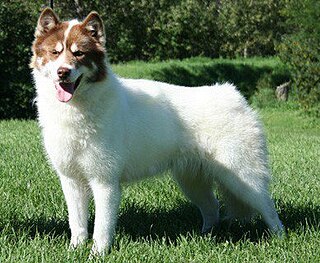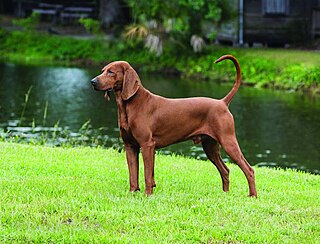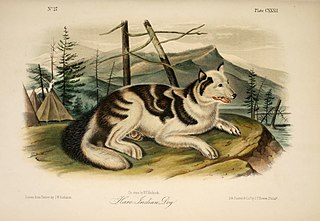
The beagle is a breed of small scent hound, similar in appearance to the much larger foxhound. The beagle was developed primarily for hunting hare, known as beagling. Possessing a great sense of smell and superior tracking instincts, the beagle is the primary breed used as a detection dog for prohibited agricultural imports and foodstuffs in quarantine around the world. The beagle is a popular pet due to its size and good temper.

The Scottish Deerhound, or simply the Deerhound, is a breed of large sighthound, once bred to hunt the red deer by coursing. In outward appearance it is similar to the Greyhound, but larger and more heavily boned, with a rough coat.

The Great Dane is a German breed of large mastiff-sighthound, which descends from hunting dogs of the Middle Ages used to hunt bears, wild boar, and deer. They were also used as guardian dogs of German nobility. It is one of the two largest dog breeds in the world, along with the Irish Wolfhound.

The German Wirehaired Pointer is a medium to large-sized griffon type breed of dog developed in the 19th century in Germany for versatile hunting. It became a leading gun dog in Germany in the later part of the 20th century. It is the result of the careful mixing and crossing of the Wirehaired Pointing Griffon, German Shorthaired Pointer, German Roughhaired Pointer, and the hunting Pudelpointer in the late 19th century.

The Norwegian Elkhound is one of the Northern Spitz-type breeds of dog and is the National Dog of Norway. The Elkhound has served as a hunter, guardian, herder, and defender. It is known for its courage in tracking and hunting elk and other large game, such as bears or wolves. The Norwegian Elkhound was first presented at a dog exhibition in Norway in 1877.

The Small Münsterländer is a versatile hunting-pointing-retrieving dog breed that reached its current form in the area around Münster, Germany. The Large Münsterländer is from the same area, but was developed from different breeding stock and is not related as the names would suggest. Small Münsterländers bear a resemblance to both spaniels and setters but are more versatile while hunting on land and water. The Small Münsterländer is recognized by the Fédération Cynologique Internationale under Group 7, Section 1.2, Continental Pointing Dogs of Spaniel type, by the American Kennel Club as a Foundation Stock Service breed, and by The Kennel Club and the United Kennel Club as a gun dog. It is related to the Epagneul Français and the Drentsche Patrijshond.

The Canadian Eskimo Dog or Canadian Inuit Dog is a breed of working dog from the Arctic. Other names include qimmiq or qimmit. The Greenland Dog is considered the same breed as the Canadian Eskimo Dog since they have not yet diverged enough genetically to be considered separate breeds, despite their geographic isolation.

The Carolina dog, also known as a yellow dog, yaller dog, American dingo, or Dixie dingo, is a breed of medium-sized dog occasionally found feral in the Southeastern United States, especially in isolated stretches of longleaf pines and cypress swamps. Efforts to establish them as a standardized breed have gained the Carolina Dog breed recognition in two smaller kennel clubs and full acceptance into the breed-establishment program of one major kennel club.

The Petit Basset Griffon Vendéen, or PBGV, is a breed of dog of the scent hound type, bred to trail hares in bramble-filled terrain of the Vendée district of France. The breed is known in the United States as "Petit" or "PBGV," in England as "Roughie," and in Denmark as "Griffon" or "Petit". The PBGV is one of six types of "basset"-type breeds recognised by the Fédération Cynologique Internationale (FCI).

The Redbone Coonhound is an American breed of hunting dog. As a coonhound, the Redbone is primarily a hunter of small game that hide in trees, such as raccoons, opossums, and squirrels, but is also capable of handling big game like bears and cougars. Its hunting strategy is to tree wild game where hunters can then shoot the target, rather than directly hunting and subduing the prey.

A feist is a small hunting dog. This group descended from the terriers brought over to the United States by British miners and other immigrants. These terriers probably included crosses between the Smooth Fox Terrier, the Manchester Terrier, and the now-extinct English White Terrier. These dogs were used as ratters, and gambling on their prowess in killing rats was a favorite hobby of their owners. Some of these dogs have been crossed with Greyhounds, Whippets or Italian Greyhounds, and Beagles or other hounds — extending the family to include a larger variety of purpose than the original ratter, or Rat Terrier.

The West Siberian Laika or WSL, is a breed of spitz–type hunting dog. Russian publications indicate that the term West Siberian Laika loosely applied to hunting dogs originating with the Mansi and Khanty people in Ural and West Siberia, but there were no standards or registrations of WSL as such until 1930. Then WWII disrupted it for a while, but systematic breeding with registrations resumed after the war ended, in 1946. This was the time the breed began taking modern shape. Before that hunters only knew of Mansi Laika and Khanty Laika. In early 1960 many hunters in Ural still preferred the term Mansi Laika, when speaking of West Siberian Laika. In Russian language, the term Laika originated from the word layat that means to bark. The word Laika simply means barker. Any hunting Laika is a bark pointer. It is a versatile dog depending on use and environment, but in certain parts of the country they have become more specialized.

Bears have been hunted since prehistoric times for their meat and fur. In addition to being a source of food, in modern times they have been favored by big game hunters due to their size and ferocity. Bear hunting has a vast history throughout Europe and North America, and hunting practices have varied based on location and type of bear.

Podenco Canario is a breed of dog from the Canary Islands. The Podenco Canario is still used today, primarily in packs, most often for the sport hunting of rabbits. The word "podenco" in Spain refers to a certain type of dog, typically rabbit hunters with the same body shape. "Canario" is a reference to its region of origin, the Canary Islands. The Spanish Kennel Club, Real Sociedad Canina de España, recognises the following similar dog breeds that use the identifier "podenco" in their names: Podenco Andaluz, Podenco Ibicenco, and Podenco Valenciano.

The Westphalian Dachsbracke is a small, short-legged scenthound, a breed of dog originating in Westphalia, a region of Germany. The Westphalian Dachsbracke was used in Sweden to develop the Drever.

The Halden Hound, is a medium-sized Norwegian dog breed of the hound class, used for hunting hares and other plains quarry. It resembles an American Foxhound but is smaller. It was named after Halden, a town in southeastern Norway.

The Hare Indian dog is an extinct domesticated canine; possibly a breed of domestic dog, coydog, or domesticated coyote; formerly found and originally bred in northern Canada by the Hare Indians for coursing. It had the speed and some characteristics of the coyote, and the domesticated temperament and other characteristics of a domestic dog. It gradually lost its usefulness as aboriginal hunting methods declined, and became extinct or lost its separate identity through interbreeding with dogs in the 19th century, though some claim the breed still exists in modified form.

The Griffon Nivernais is a breed of dog of the scenthound type, originating in France. It is a versatile hunting dog, used on small and large game, in packs or individually. Today's breed is a reconstruction of an ancient type of dog from the Nivernais region.

African village dogs are dogs found in Africa that are directly descended from an ancestral pool of indigenous dogs. African village dogs became the close companion of people in Africa, beginning in North Africa and spreading south.

Pampas Deerhound is a Brazilian breed of hunting dog; it is also found in Argentina and Uruguay. It is common in Brazil, where it was first recognized by a national kennel club. The dogs were used to track, capture, and hunt deer, and thus earned the name Pampas Deerhound. It is still a widely preferred hunting companion to track other animals, such as wild boars.




















